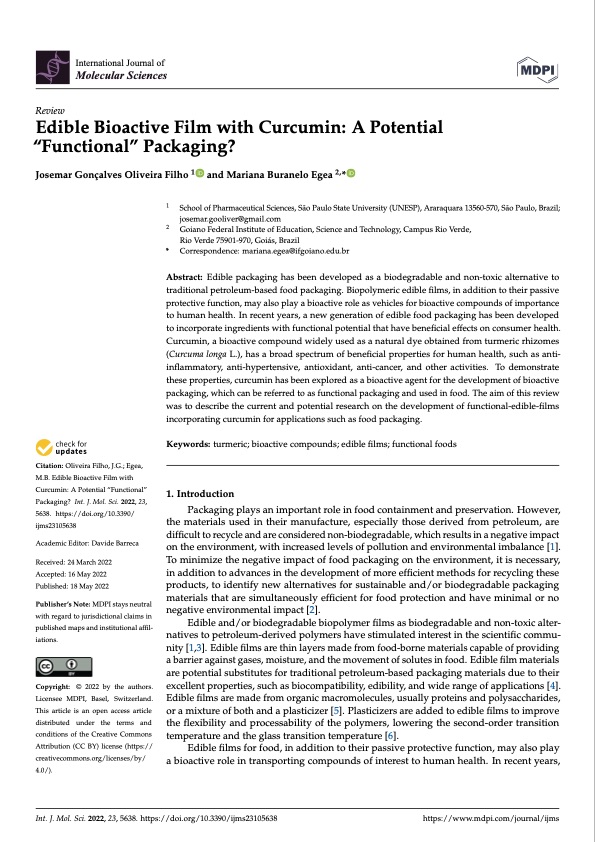
PDF Publication Title:
Text from PDF Page: 001
International Journal of Molecular Sciences Review Edible Bioactive Film with Curcumin: A Potential “Functional” Packaging? Josemar Gonçalves Oliveira Filho 1 and Mariana Buranelo Egea 2,* 1 2 * Correspondence: mariana.egea@ifgoiano.edu.br Abstract: Edible packaging has been developed as a biodegradable and non-toxic alternative to traditional petroleum-based food packaging. Biopolymeric edible films, in addition to their passive protective function, may also play a bioactive role as vehicles for bioactive compounds of importance to human health. In recent years, a new generation of edible food packaging has been developed to incorporate ingredients with functional potential that have beneficial effects on consumer health. Curcumin, a bioactive compound widely used as a natural dye obtained from turmeric rhizomes (Curcuma longa L.), has a broad spectrum of beneficial properties for human health, such as anti- inflammatory, anti-hypertensive, antioxidant, anti-cancer, and other activities. To demonstrate these properties, curcumin has been explored as a bioactive agent for the development of bioactive packaging, which can be referred to as functional packaging and used in food. The aim of this review was to describe the current and potential research on the development of functional-edible-films incorporating curcumin for applications such as food packaging. Keywords: turmeric; bioactive compounds; edible films; functional foods 1. Introduction Packaging plays an important role in food containment and preservation. However, the materials used in their manufacture, especially those derived from petroleum, are difficult to recycle and are considered non-biodegradable, which results in a negative impact on the environment, with increased levels of pollution and environmental imbalance [1]. To minimize the negative impact of food packaging on the environment, it is necessary, in addition to advances in the development of more efficient methods for recycling these products, to identify new alternatives for sustainable and/or biodegradable packaging materials that are simultaneously efficient for food protection and have minimal or no negative environmental impact [2]. Edible and/or biodegradable biopolymer films as biodegradable and non-toxic alter- natives to petroleum-derived polymers have stimulated interest in the scientific commu- nity [1,3]. Edible films are thin layers made from food-borne materials capable of providing a barrier against gases, moisture, and the movement of solutes in food. Edible film materials are potential substitutes for traditional petroleum-based packaging materials due to their excellent properties, such as biocompatibility, edibility, and wide range of applications [4]. Edible films are made from organic macromolecules, usually proteins and polysaccharides, or a mixture of both and a plasticizer [5]. Plasticizers are added to edible films to improve the flexibility and processability of the polymers, lowering the second-order transition temperature and the glass transition temperature [6]. Edible films for food, in addition to their passive protective function, may also play a bioactive role in transporting compounds of interest to human health. In recent years, School of Pharmaceutical Sciences, São Paulo State University (UNESP), Araraquara 13560-570, São Paulo, Brazil; josemar.gooliver@gmail.com Goiano Federal Institute of Education, Science and Technology, Campus Rio Verde, Rio Verde 75901-970, Goiás, Brazil Citation: Oliveira Filho, J.G.; Egea, M.B. Edible Bioactive Film with Curcumin: A Potential “Functional” Packaging? Int. J. Mol. Sci. 2022, 23, 5638. https://doi.org/10.3390/ ijms23105638 Academic Editor: Davide Barreca Received: 24 March 2022 Accepted: 16 May 2022 Published: 18 May 2022 Publisher’s Note: MDPI stays neutral with regard to jurisdictional claims in published maps and institutional affil- iations. Copyright: © 2022 by the authors. Licensee MDPI, Basel, Switzerland. This article is an open access article distributed under the terms and conditions of the Creative Commons Attribution (CC BY) license (https:// creativecommons.org/licenses/by/ 4.0/). Int. J. Mol. Sci. 2022, 23, 5638. https://doi.org/10.3390/ijms23105638 https://www.mdpi.com/journal/ijmsPDF Image | Edible Bioactive Film with Curcumin

PDF Search Title:
Edible Bioactive Film with CurcuminOriginal File Name Searched:
ijms-23-05638.pdfDIY PDF Search: Google It | Yahoo | Bing
Salgenx Redox Flow Battery Technology: Salt water flow battery technology with low cost and great energy density that can be used for power storage and thermal storage. Let us de-risk your production using our license. Our aqueous flow battery is less cost than Tesla Megapack and available faster. Redox flow battery. No membrane needed like with Vanadium, or Bromine. Salgenx flow battery
| CONTACT TEL: 608-238-6001 Email: greg@salgenx.com | RSS | AMP |